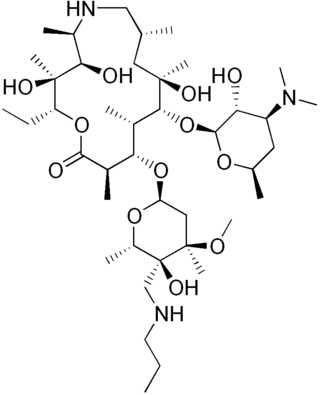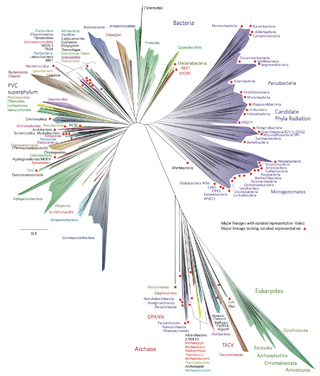Related Research Articles

Pasteurellosis is an infection with a species of the bacterial genus Pasteurella, which is found in humans and other animals.

The Pasteurellaceae comprise a large family of Gram-negative bacteria. Most members live as commensals on mucosal surfaces of birds and mammals, especially in the upper respiratory tract. Pasteurellaceae are typically rod-shaped, and are a notable group of facultative anaerobes. Their biochemical characteristics can be distinguished from the related Enterobacteriaceae by the presence of oxidase, and from most other similar bacteria by the absence of flagella.
The indole test is a biochemical test performed on bacterial species to determine the ability of the organism to convert tryptophan into indole. This division is performed by a chain of a number of different intracellular enzymes, a system generally referred to as "tryptophanase."

Florfenicol is a fluorinated synthetic analog of thiamphenicol, mainly used as a antibiotic in veterinary medicine.

Pasteurella multocida is a Gram-negative, nonmotile, penicillin-sensitive coccobacillus of the family Pasteurellaceae. Strains of the species are currently classified into five serogroups based on capsular composition and 16 somatic serovars (1–16). P. multocida is the cause of a range of diseases in mammals and birds, including fowl cholera in poultry, atrophic rhinitis in pigs, and bovine hemorrhagic septicemia in cattle and buffalo. It can also cause a zoonotic infection in humans, which typically is a result of bites or scratches from domestic pets. Many mammals and birds harbor it as part of their normal respiratory microbiota.

Tulathromycin, sold under the brand name Draxxin among others, is a macrolide antibiotic used to treat bovine respiratory disease in cattle and swine respiratory disease in pigs.

Bacterial phyla constitute the major lineages of the domain Bacteria. While the exact definition of a bacterial phylum is debated, a popular definition is that a bacterial phylum is a monophyletic lineage of bacteria whose 16S rRNA genes share a pairwise sequence identity of ~75% or less with those of the members of other bacterial phyla.

Tilmicosin is a macrolide antibiotic. It is distributed under the brand name Micotil. It is used in veterinary medicine for the treatment of bovine respiratory disease and enzootic pneumonia caused by Mannheimia (Pasteurella) haemolytica in sheep. In humans, Tilmicosin causes fatal cardiotoxic effects at amounts greater than 1 milliliter when injected, something most commonly seen in veterinary personnel and farmers. Tilmicosin, like most macrolides, is a Calcium channel blocker. However, because Micotil is formulated for animals like cows, it has exceptionally more potent Ca channel blocking effects in humans with a dose of .5 mL causing significant poisoning and a dose of 5-6 ml being lethal.
Pasteurella canis is a Gram-negative, nonmotile, penicillin-sensitive coccobacillus of the family Pasteurellaceae. Bacteria from this family cause zoonotic infections in humans, which manifest themselves as skin or soft-tissue infections after an animal bite. It has been known to cause serious disease in immunocompromised patients.
Mannheimia ruminalis is a bacterium. It is pathogenic.
Actinobacillus rossii is a bacterium. It was first isolated from the vaginas of postparturient sows.
Actinobacillus seminis is a Gram-negative bacterium associated with epididymitis of sheep.
Pasteurella lymphangitidis is a bacterium; it causes bovine lymphangitis. Its reclassification to Yersinia has been proposed, given it poses a 99% sequence similarity to both Yersinia pseudotuberculosis and Yersinia pestis.
Pasteurella mairii is a Gram-negative bacterium. It causes abortion in sows.
Bovine respiratory disease (BRD) is the most common and costly disease affecting beef cattle in the world. It is a complex, bacterial or viral infection that causes pneumonia in calves which can be fatal. The infection is usually a sum of three codependent factors: stress, an underlying viral infection, and a new bacterial infection. The diagnosis of the disease is complex since there are multiple possible causes.
Elizabethkingia is a genus of bacterium described in 2005, named after Elizabeth O. King, the discoverer of the type species. Before this genus being formed in 2005, many of the species of Elizabethkingia were classified in the Chryseobacterium genus. Elizabethkingia has been found in soil, rivers, and reservoirs worldwide.
Histophilus somni is a non-motile, gram-negative, rod or coccobacillus shaped, facultative anaerobe bacterial species belonging to the family Pasteurellaceae. Prior to 2003, it was thought Haemophilus somnus, Histophilus ovis, and Histophilus agni were three different species, but now are all classified as Histophilus somni. Histophilus somni is a commensal bacteria of mucous membranes of the upper respiratory tract and reproductive tract with a global prevalence and is found in cattle and other small ruminants. Histophilus somni is also a known causative agent that is a part of the Bovine Respiratory Disease (BRD) complex, which typically involves multiple pathogens residing together in biofilm environments. Histophilus somni may also cause Histophilosus symptoms and clinical presentation will depend on the tissue affected. When disease does occur, it can be difficult to catch in time and is often diagnosed on post mortem. This means that treatment often involves metaphylactic mass treatment or no treatment at all. This organism is more fastidious than others and requires knowledge for sample collection, storage and culture. Genomic studies related to this bacteria have enabled scientist to pin point antibiotic resistance genes.
Bibersteinia is a Gram-negative and non-motile, genus of bacteria from the family of Pasteurellaceae with one known species. Bibersteinia is named after Ernst L. Biberstein. Bibersteinia trehalosi is a pathogen of sheep and can cause systemic infections in sheep.
Actinobacillus equuli is a gram-negative, non-motile rod bacteria from the family Pasteurellaceae.
Bovine respiratory syncytial virus (BRSV) is pneumovirus closely related to human respiratory syncytial virus (RSV) that is a common cause of respiratory disease in cattle, particularly calves. It is a negative-sense, single-stranded RNA virus that replicates in the cytoplasm of the cell. Similarly to other single-stranded RNA viruses, the genome of BRSV has a high mutation rate, which results in great antigenetic variation. Thus, BRSV can be split into four different subgroups based on antigen expression.
References
- ↑ Angen, O.; Mutters, R.; Caugant, D. A.; Olsen, J. E.; Bisgaard, M. (1999). "Taxonomic relationships of the [Pasteurella] haemolytica complex as evaluated by DNA-DNA hybridizations and 16S rRNA sequencing with proposal of Mannheimia haemolytica gen. nov., comb, nov., Mannheimia granulomatis comb. nov., Mannheimia glucosida sp. nov., Mannheimia ruminalis sp. nov. and Mannheimia varigena sp. nov". International Journal of Systematic Bacteriology. 49 (1): 67–86. doi: 10.1099/00207713-49-1-67 . ISSN 0020-7713. PMID 10028248.
- ↑ Poulsen, Louise L; Reinert, Turið M; Sand, Rikke L; Bisgaard, Magne; Christensen, Henrik; Olsen, John E; Stuen, Snorre; Bojesen, Anders M (2006). "Occurrence of haemolytic Mannheimia spp. in apparently healthy sheep in Norway". Acta Veterinaria Scandinavica. 48 (1): 19. doi: 10.1186/1751-0147-48-19 . ISSN 1751-0147. PMC 1949873 . PMID 17076903.
- ↑ Catry B, Opsomer G, Decostere A, Feyen B, de Kruif A, Haesebrouck F (December 2004). "Fatal meningitis in a calf caused by Mannheimia varigena". Research in Veterinary Science . 77 (3): 187–8. doi:10.1016/j.rvsc.2004.04.002. PMC 7130721 . PMID 15276768.